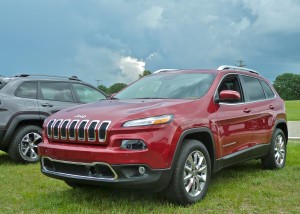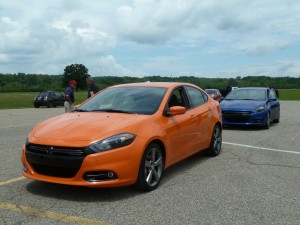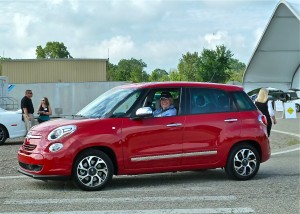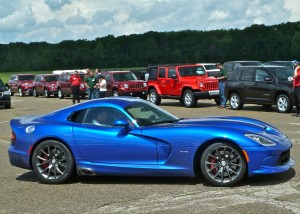New Engines Lift 2014 Dodge, Jeep, Ram
By John Gilbert
DETROIT, MI.
You don’t have to be a resident to sympathize with Detroit’s well-publicized bankruptcy struggles, much in the way you didn’t have to own a Chrysler vehicle to sympathize when that proud Detroit company went into bankruptcy four years ago. We can only hope the city recovers as impressively as Chrysler has.
A brief glimpse at Chrysler Group LLC’s array of 2014 products at the company’s Chelsea proving grounds offers evidence that under the guidance of Fiat, the folks at Chrysler, Dodge, Jeep, Ram, and Fiat are definitely headed in the right direction. We hit Chrysler’s Chelsea proving grounds in Auburn Hills on a day that alternated between bright sunshine and quick-striking thunderstorms, which made some test drives more exciting than usual.
Chrysler competitors are flaunting more power and bigger engines, such as in the Corvette and new pickups at General Motors, or EcoBoost performance from smaller engines across the line at Ford, but Chrysler Group LLC is attempting to cover both extremes, as well as everything in between.
Fiat appears intent on making sure Chrysler continues to be known for its engineering, and no vehicle better exhibits that than the Dart, an attractive compact that perfectly fits the definition of a global venture. Dodge is the beneficiary of its own engineering and design, plus the the expertise of Fiat’s Alfa Romeo chassis engineers and Fiat’s unique MultiAir technology, and the Tiger Shark engine designed by Hyundai in Korea.
The Fiat 500 mini car gets surprising performance out of its tiny, 1.4-liter 4-cylinder by using MultiAir, which eliminates the need for an intake camshaft and instead uses a system of oil-pressured tubes that allow the exhaust valves to actuate the intake valves. It is a system that has been used on Formula 1 engines, and allows infinite valve overlap for more complete combustion. It also could be adapted to any engine, and the first attempt at that is the Tiger Shark 2.4-liter engine.
The Dart came out new as a 2013, but without the GT model, which is the one with the new MultiAir Tiger Shark engine. The Dart GT is ready to go as a 2014 model, which should help inspire a new wave of popularity for the well-designed global compact, and I got the chance to run a couple of GT models around the big test track and the intricate infield road course and found it to be satisfyingly strong in both stick or manual transmission form.
The 2.4-liter MultiAir develops 184 horsepower and 171 foot-pounds of torque and gets an estimated 41 miles per gallon. Dodge is wisely going to also use the new engine in the SXT and Limited Dart models, as well as the top-of-the-line GT, which starts at $20,995. The GT and SXT offer a manual transmission or the slick, Hyundai-sourced 6-speed automatic. The base SE offers a 2.0 version of the 2.4, while the Aero model will use the Fiat Abarth’s 1.4-liter MultiAir turbo.
The new 2.4 MultiAir will also power another intriguing vehicle: The entirely new Jeep Cherokee. Not to be confused with the larger Grand Cherokee, the Cherokee will take serious aim at the Ford Escape and Honda CR-V, with decisively flashy styling and both the 2.4 MultiAir and a downsized 3.2-liter version of the 3.6 Pentastar V6.
“The Dart has been getting more consideration from younger buyers, and we think the MultiAir engine will help give it more recognition,” said Chris Barman. “The Dart has a unique design and styling, and now it covers all the angles of performance and mileage. The Dart is built on the ‘CUSY’ platform, which started as the underpinning for the Alfa Giulietta.”
That platform is flexible, and can be widened and lengthened for whatever use is needed. Widening the platform means the Dart platform works under the new Cherokee, too. Barman, who is the vehicle line executive for both the Dart and Cherokee, said she has worked at Chrysler for 19 years, after attaining a BS degree in mechanical engineering from Purdue. She worked in brake engineering on larger-platform cars, and on electronic stability programs when Chrysler was owned by Daimler. “We’re still using that stability program standard in our vehicles,” she said.
She works with lJim Morrison, director of Jeep brand marketing, on the Cherokee, which will represent a breakthrough as the first Jeep built on a front-wheel-drive platform. In the Cherokee, the 2.4 MultiAir will be engineered for 180 horsepower, slightly down from the Dart’s 184, and will anticipated fuel economy of 30-plus miles per gallon.
“The 2.4 MultiAir will be in the Trailhawk model,” Morrison said. “The Limited will have the 3.2 V6 with 260 horsepower and a 4,500-pound towing capacity, and will have a new 9-speed automatic transmission. ZF, which designed our 8-speed automatic, has also done the new 9-speed.
“It’s important for us to make sure the Cherokee is very capable to live up to Jeep’s reputation. Because it starts with front-wheel-drive architecture, we’ve designed a new ActiveDrive all-wheel-drive system, which can send 100 percent of the power to one wheel, if needed. We ran the Rubicon Trail with it, and our Jeep engineers have done a fantastic job, taking the very stiff platform, with independent suspension and the new ActiveDrive, and it offers a quiet ride on the road, and it has all the power and performance you could want off-road,”
Back on the road, the tiny Fiat 500 and the Dart start from the economy end but with engaging pep. Fiat has some interesting new variations with the 500, introducing an extended 4-door version that increases flexibility, while the hot-running Abarth lends its turbocharged 1.4-liter engine to the “normal” 500 to create a classic sleeper model, that night still reach the magical 40 miles per gallon plateau.
At the opposite end, there are all the SRT models, including Dodge Charger and Challenger, Chrysler 300, and the Jeep Grand Cherokee, all armed with larger and more potent 6.4-liter Hemi V8s. But above and beyond those vehicles is the return of the company’s halo car — the reinvigorated new Viper.
After the economy ended the Viper’s run, it has made impressive strides in its resurrection, rising from huge but crude power to the sophistication of becoming a true exotic sports car. The Viper’s eye-catching lines flow better on the new model, and it exudes power and performance. The aluminum 8.4-liter V10 engine is nothing short of awesome, with 640 horsepower and 600 horsepower. It’s lighter chassis has 50 percent improved torsional stiffness, and its performance has been measured at 0-60 in 3.8 seconds, and 0-11 in less than 12 seconds, with a top speed of 206 mph, and a 60-0 stopping distance of only 106 feet.
We weren’t supposed to report on driving impressions for the Viper yet, which is just as well. I had gotten my name onto the list to drive the car, with an accompanying engineer, but just as I approached we had a cloudburst. Undaunted, I climbed behind the wheel. We did go for a brief ride, and while I was impressed that tapping the gas pedal didn’t cause the Viper to slew sideways on the wet track, I can honestly say that I can keep my driving impressions to myself — at least until I get a Viper for a week-long test on dry pavement.
Chrysler and Dodge cars, and Jeeps and Fiats have all been upgraded, but don’t overlook the Ram trucks, which ask to no longer be referred to as “Dodge.”
The increasingly popular Ram pickups bolster their standard Hemi V8 and Pentastar V6 with a new 6.4-liter Hemi that is designed specifically for the trucks with 410 horsepower and 429 foot-pounds of torque. The spotlight, however, may shine on the addition of a light, 3.0-liter turbo-diesel. The only light diesel in a half-ton pickup should exceed the Pentastar’s outstanding 25 mpg, while putting out 240 horsepower and a whopping 420 foot-pounds of torque — more than the Cummins diesel produced in 1989. The 3.0 Turbodiesel is built by VM Motori, a Fiat affiliate, and it has already proven to top 30 mpg in the Jeep Grand Cherokee.
The bigger 2500 and 3500 Rams also have a new Cummins diesel, with a mind-blowing 850 foot-pounds of torque for ultra-heavy towing tasks. The Ram truck family also transfers the independent air suspension from the 1500 to the heftier 2500 and 3500 heavy-duty trucks.
When automotive media types are invited to Detroit, we fly to the modern airport, and we either stay right there, at the Airport Westin, or we are whisked to some nice suburban hotel in Dearborn, or Auburn Hills. We don’t generally get exposed to the desolation and boarded-up buildings in the inner city of Detroit. Checking out the new stuff from Dodge, Jeep, Ram and Chrysler tend to distance us even further. Maybe that’s a good thing. Maybe Chrysler’s “imported from Detroit” rallying cry can be a beacon for the city’s future.
Comments
Tell me what you're thinking...
and oh, if you want a pic to show with your comment, go get a gravatar!







 John Gilbert is a lifetime Minnesotan and career journalist, specializing in cars and sports during and since spending 30 years at the Minneapolis Tribune, now the Star Tribune. More recently, he has continued translating the high-tech world of autos and sharing his passionate insights as a freelance writer/photographer/broadcaster. A member of the prestigious North American Car and Truck of the Year jury since 1993. John can be heard Monday-Friday from 9-11am on 610 KDAL(www.kdal610.com) on the "John Gilbert Show," and writes a column in the Duluth Reader.
John Gilbert is a lifetime Minnesotan and career journalist, specializing in cars and sports during and since spending 30 years at the Minneapolis Tribune, now the Star Tribune. More recently, he has continued translating the high-tech world of autos and sharing his passionate insights as a freelance writer/photographer/broadcaster. A member of the prestigious North American Car and Truck of the Year jury since 1993. John can be heard Monday-Friday from 9-11am on 610 KDAL(www.kdal610.com) on the "John Gilbert Show," and writes a column in the Duluth Reader.